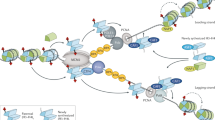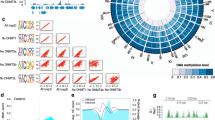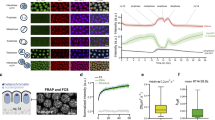Abstract
During development and differentiation, cellular phenotypes are stably propagated through numerous cell divisions1. This epigenetic ‘cell memory’ helps to maintain stable patterns of gene expression2. DNA methylation3 and the propagation of specific chromatin structures may both contribute to cell memory4. There are two impediments during the cell cycle that can hinder the inheritance of specific chromatin configurations: first, the pertinent structures must endure the passage of DNA-replication forks in S phase5; second, the chromatin state must survive mitosis, when chromatin condenses, transcription is turned off, and almost all double-stranded DNA-binding proteins are displaced6,7. After mitosis, the previous pattern of expressed and silent genes must be restored. This restoration might be governed by mass action, determined by the binding affinities and concentrations of individual components. Alternatively, a subset of factors might remain bound to mitotic chromosomes, providing a molecular bookmark to direct proper chromatin reassembly. Here we analyse DNA at transcription start sites during mitosis invivo and find that it is conformationally distorted in genes scheduled forreactivation but is undistorted in repressed genes. Theseprotein-dependent conformational perturbations could help to re-establish transcription after mitosis by ‘marking’ genes for re-expression.
This is a preview of subscription content, access via your institution
Access options
Subscribe to this journal
Receive 51 print issues and online access
$199.00 per year
only $3.90 per issue
Buy this article
- Purchase on Springer Link
- Instant access to full article PDF
Prices may be subject to local taxes which are calculated during checkout




Similar content being viewed by others
References
Alberts, B.et al. Molecular Biology of the Cell(Garland, New York and London, (1994)).
Weintraub, H. Assembly and propagation of repressed and depressed chromosomal states. Cell 42, 705–711 (1985).
Martienssen, R. A. & Richards, E. J. DNA methylation in eukaryotes. Curr. Opin. Genet. Dev. 5, 234–242 (1995).
Groudine, M. & Weintraub, H. Propagation of globin DNAase I-hypersensitive sites in absence of factors required for induction: a possible mechanism for determination. Cell 30, 131–139 (1982).
Liu, B. & Alberts, B. M. Head-on collision between a DNA replication apparatus and RNA polymerase transcription complex. Science 267, 1131–1137 (1995).
Martinez-Balbas, M. A., Dey, A., Rabindran, S. K., Ozato, K. & Wu, C. Displacement of sequence-specific transcription factors from mitotic chromatin. Cell 83, 29–38 (1995).
Segil, N., Guermah, M., Hoffmann, A., Roeder, R. G. & Heintz, N. Mitotic regulation of TFIID: inhibition of activator-dependent transcription and changes in subcellular localization. Genes Dev. 10, 2389–2400 (1996).
Larsen, A. & Weintraub, H. An altered DNA conformation detected by S1 nuclease occurs at specific regions in active chick globin chromatin. Cell 29, 609–622 (1982).
Michelotti, E. F., Michelotti, G. A., Aronsohn, A. & Levens, D. Heterogeneous nuclear ribonucleoprotein K is a transcription factor. Mol. Cell. Biol. 16, 2350–2360 (1996).
Michelotti, G. A.et al. Multiple single-stranded cis elements are associated with activated chromatin of the human c-myc gene in vivo. Mol. Cell. Biol. 16, 2656–2669 (1996).
Duncan, R.et al. Asequence-specific, single-strand binding protein activates the far upstream element of c-myc and defines a new DNA binding motif. Genes Dev. 8, 465–480 (1994).
Juan, G., Pan, W. & Darzynkiewicz, Z. DNA segments sensitive to single-strand-specific nucleases are present in chromatin of mitotic cells. Exp. Cell Res. 227, 197–202 (1996).
Giardina, C., Perez-Riba, M. & Lis, J. T. Promoter melting and TFIID complexes on Drosophila genes in vivo. Genes Dev. 6, 2190–2200 (1992).
Mavrothalassitis, G. W., Watson, D. K. & Papas, T. The human ETS-2 gene promoter: molecular dissection and nuclease hypersensitivity. Oncogene 5, 1337–1342 (1990).
Koiwai, O. & Morita, A. Isolation of a putative promoter region for human terminal deoxynucleotidyltransferase gene. Biochem. Biophys. Res. Commun. 154, 91–100 (1988).
Bhaumik, D.et al. Identification of a tripartite basal promoter which regulates human terminal deoxynucleotidyl transferase gene expression. J. Biol. Chem. 269, 15861–15867 (1994).
Schweizer, D. & Ambros, P. F. Chromosome Analysis Protocols1-97-112 (Humana, Totowa, (1994)).
Bonne-Andrea, C., Wong, M. L. & Alberts, B. M. In vitro replication through nucleosomes without histone displacement. Nature 343, 719–726 (1990).
Kahn, J. D., Yun, E. & Crother, D. M. Detection of localized DNA flexibility. Nature 368, 163–166 (1994).
Castano, I. B., Brzoska, P. M., Sadoff, B. U., Chen, H. & Christman, M. F. Mitotic chromosome condensation in the rDNA requires TRF4 and DNA topoisomerase I in Saccharomyces cerevisiae. Genes Dev. 10, 2546–2576 (1996).
Mueller, P. R. & Wold, B. In vivo footprinting of a muscle specific enhancer by ligation mediated PCR. Science 246, 780–786 (1989).
Acknowledgements
We thank L. Liotta, C. Wu, S. Mackem and M. Reitman for critical review of the manuscript.
Author information
Authors and Affiliations
Rights and permissions
About this article
Cite this article
Michelotti, E., Sanford, S. & Levens, D. Marking of active genes on mitotic chromosomes. Nature 388, 895–899 (1997). https://doi.org/10.1038/42282
Received:
Accepted:
Issue Date:
DOI: https://doi.org/10.1038/42282
This article is cited by
-
Release of Histone H3K4-reading transcription factors from chromosomes in mitosis is independent of adjacent H3 phosphorylation
Nature Communications (2023)
-
Nuclear architecture and the structural basis of mitotic memory
Chromosome Research (2023)
-
Nucleolin is required for multiple centrosome-associated functions in early vertebrate mitosis
Chromosoma (2023)
-
Regulated interaction of ID2 with the anaphase-promoting complex links progression through mitosis with reactivation of cell-type-specific transcription
Nature Communications (2022)
-
The Trithorax group protein ASH1 requires a combination of BAH domain and AT hooks, but not the SET domain, for mitotic chromatin binding and survival
Chromosoma (2021)
Comments
By submitting a comment you agree to abide by our Terms and Community Guidelines. If you find something abusive or that does not comply with our terms or guidelines please flag it as inappropriate.



